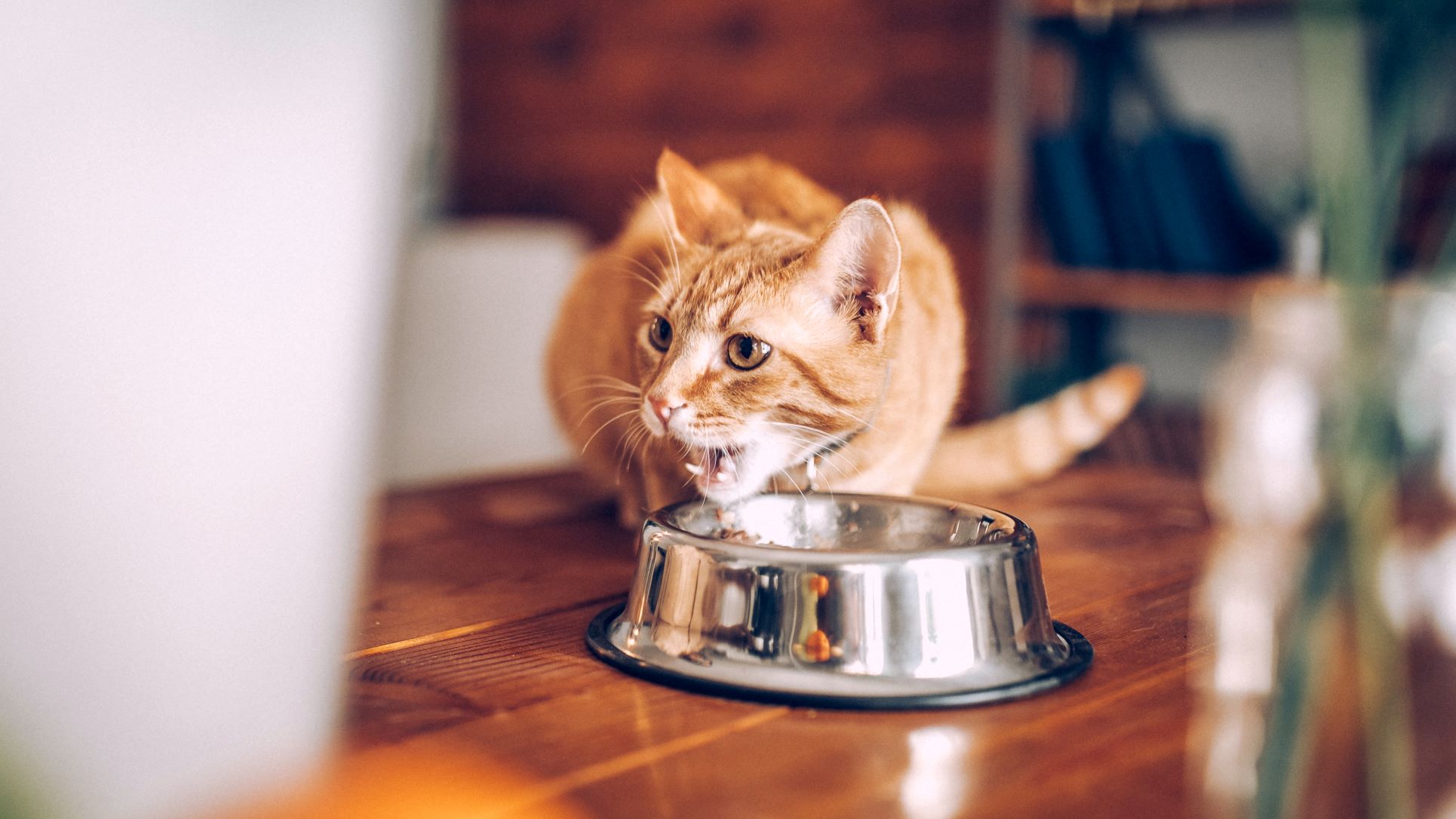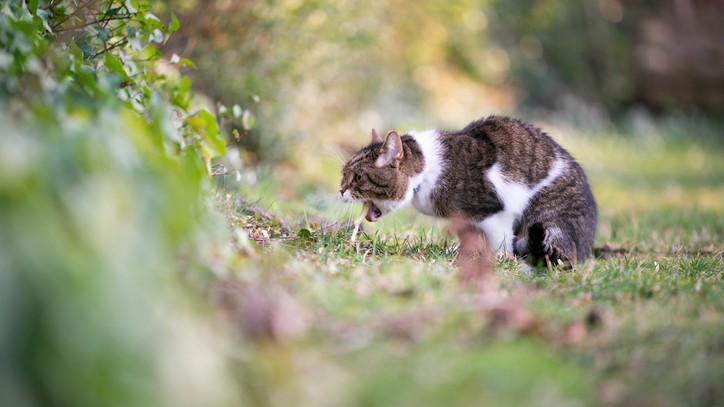Do anti-vomit cat bowls work? A vet’s opinion
Do anti-vomit cat bowls work to prevent vomiting in cats? It depends

If you’ve ever watched your cat gorge themselves on food and then immediately vomit that undigested food up onto your brand-new living room rug, you may have asked yourself, “do anti-vomit cat bowls work?” After all, these bowls are often touted on the internet as a solution to all feline vomiting problems!
Unfortunately, there’s no simple, straightforward answer to that question. The efficacy of anti-vomit cat bowls depends on your specific cat and the underlying cause of their vomiting. In most cases, a combination of veterinary care and some trial-and-error are needed to address repetitive vomiting in cats.
Some cats vomit due to an underlying medical condition. Even if your cat is eating the best dry cat food, conditions like intestinal parasites, foreign body obstruction, inflammatory bowel disease, dietary insensitivity, and some intestinal cancers can lead to chronic vomiting. Clearly, an anti-vomit food bowl is unlikely to significantly improve these conditions. Cats with a serious underlying medical condition need veterinary care, including diagnostic testing and effective treatment.
In some cases, however, vomiting has a more benign cause. Maybe your cat simply ingests their food more quickly than they can digest it, leading to an overly-full stomach and vomiting. If this is the case, switching to the best anti-vomit bowl for cats and making some other simple modifications to your cat’s diet and routine may be all that’s needed to successfully address your cat’s vomiting. Puzzle bowls can also prevent a cat eating too fast.
Why do cats throw up after eating?
There are many possible causes of post-meal vomiting. A variety of gastrointestinal conditions are associated with vomiting, including intestinal parasites, food allergies, inflammatory bowel disease, intestinal cancer, and intestinal foreign bodies (toys or other objects that become trapped in the intestines and lead to an obstruction). Feline vomiting can also be caused by systemic diseases, such as diabetes, kidney disease, hyperthyroidism, and others.
If you’re wondering what to do if your cat is throwing up, your first step should be a visit to your veterinarian. Your veterinarian will obtain a thorough medical history, asking a number of questions about your cat’s vomiting habits. Next, your veterinarian will perform a thorough physical exam. During this exam, your veterinarian will look for signs of weight loss and dehydration. Your cat’s abdomen will be palpated thoroughly, looking for any abdominal masses or thickening of the intestines. Finally, your veterinarian will look for signs of other illnesses that may be associated with vomiting. Based on your cat’s medical history and exam findings, your veterinarian may be able to start narrowing down the potential causes of your cat’s post-meal vomiting.
Next, your veterinarian will recommend appropriate diagnostic testing. These tests may include a fecal parasite examination, complete blood cell count (CBC), serum biochemistry profile, and thyroid panel. A fecal parasite exam is used to look for intestinal parasites that may cause vomiting, while blood tests can be used to look for conditions occurring outside of the intestinal tract (such as diabetes, renal failure, hyperthyroidism, etc.). Your veterinarian may also recommend imaging, such as abdominal radiographs (x-rays) and/or abdominal ultrasound, to look for signs of masses, foreign bodies, and other changes in the structure of the gastrointestinal tract. Additional testing may include intestinal biopsies (to look for microscopic changes within the gastrointestinal tract) or a food trial (to rule out food allergies).
In some cases, the cause of post-meal vomiting cannot be identified, even after an extensive workup. There are several theories about why cats may vomit after meals in the absence of an underlying medical issue. Some cats eat very quickly, which may cause their stomach to become overly full, resulting in vomiting. Some cats may be sensitive to certain food textures; dry cat food, for example, may irritate the walls of the stomach in some cats and make the cat more likely to vomit after eating. In some cats, neither of these possible causes appears to be involved and the cause of post-meal vomiting remains a mystery.

Do cats need elevated bowls?
If a thorough medical workup has ruled out underlying gastrointestinal disease, some owners turn to elevated food bowls that are designed to reduce post-meal vomiting in cats. The theory behind these bowls is that cats who eat quickly, especially those eating from a bowl on the ground, are more likely to have food become retained within the esophagus instead of moving all the way to the stomach. Food that remains trapped in the esophagus is not held in place by a sphincter and therefore may be regurgitated after the cat eats. The use of a raised bowl is intended to help food move “downhill,” using gravity, from the mouth, to the esophagus, to the stomach. In theory, this may make the regurgitation of undigested food less likely.
While some owners report success with elevated food bowls, there is no scientific evidence to suggest that they are necessary or beneficial. There is no medical reason that cats need to eat from an elevated bowl; if you think of cats in the wild, they typically eat their prey off the ground. It certainly wouldn’t hurt your cat to try an elevated anti-vomiting bowl, but this may or may not help reduce the frequency of your cat’s vomiting.
Are there other anti-vomiting cat bowls that can help cats?
While raised food bowls may have unpredictable results, there is another intervention that veterinarians often recommend for cats with unexplained vomiting after eating. This is a slow-feeder bowl, also known as a puzzle feeder. These food bowls contain obstacles that force cats to slow down and eat their food one bite at a time, instead of “inhaling” their food (as many cats are prone to do). If you would prefer a more active alternative to a conventional slow feeder, you can even purchase a hunting feeder. Hunting feeders operate under a similar principle, dispensing food slowly, but also provide your cat with a bit more physical activity.
While there is limited evidence to support the effect of puzzle feeders on vomiting, their use is associated with many other benefits, including stress reduction. Anecdotally, many veterinarians have seen puzzle feeders effectively used to decrease post-meal vomiting in cats that do not have an underlying medical condition at the root of their vomiting.
Does a raised food bowl help reduce vomiting?
The answer to the question “do anti-vomit cat bowls work?” is not a straightforward one. There is no direct evidence to demonstrate that elevated bowls or puzzle feeders are effective in reducing post-meal vomiting. However, many veterinarians report positive results when feeding cats from a slow feeder or puzzle feeder, as long as other medical conditions have been ruled out, and some cat owners find that elevated bowls are beneficial. If your cat is regularly vomiting after meals, talk to your veterinarian. They can help you rule out underlying medical causes of the vomiting and provide guidance on the best food and food bowls for your cat.
Whether you're looking for the best dry cat foods or the best wet cat foods, we've rated the best brands to make your search easier. Or, if you want to give your pet free choice running water and never refill a water bowl again, check out our guide to the best pet water fountains.

Dr. Barnette graduated from the University of Florida in 2006 where she received both her B.S. in Zoology and her Doctor of Veterinary Medicine (DVM). She has 15 years of clinical experience as a small animal veterinarian, treating dogs, cats, and occasional exotic patients. When she’s not writing content as a freelance veterinary writer, Dr. Barnette lives in southwest Florida with her husband and daughter (plus two cats, a dog, and a rescued dove!) and enjoys kayaking, biking, and hiking.
PetsRadar Newsletter
Get the best advice, tips and top tech for your beloved Pets
Dr. Barnette is a graduate of the University of Florida, where she received both her B.S. in Zoology and her Doctor of Veterinary Medicine (DVM). She has 15 years of clinical experience as a small animal veterinarian, treating dogs, cats, and occasional exotic patients. She now works as a freelance veterinary writer, creating educational content for veterinarians, veterinary team members, and dedicated pet owners. Dr. Barnette lives in southwest Florida with her husband and daughter (plus two cats, a dog, and a rescued dove!) and enjoys kayaking, biking, and hiking. Learn more about Dr. Barnette at www.linkedin.com/in/catherinebarnette.

